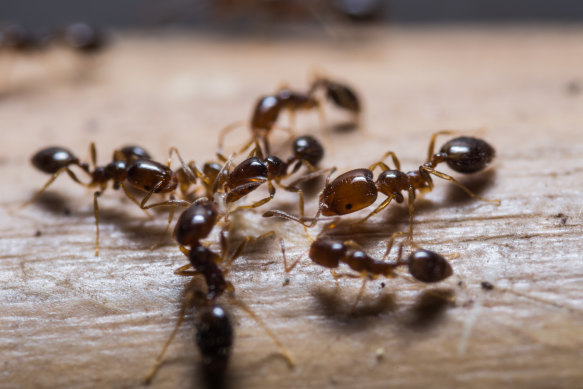Looming fire ant invasion ‘worse than cane toads’
Experts fear Australia is at risk of being overwhelmed by potentially lethal fire ants due to a lack of funding and political support for the ant eradication program.
Scientists dread fire ants breaking out of their 20-year stronghold in and around Brisbane and potentially impacting human life, agriculture and native ecosystems across the country.

A close-up of red imported fire ants.Credit: iStock
“They just have a particularly potent venom and studies around the world show three per cent of all people will have severe allergic reactions and could need hospitalisation if bitten,” said CSIRO invasive ant specialist Dr Ben Hoffman.
“If you put that in perspective, three per cent of the population of the east coast is a few hundred thousand people that potentially would be at risk of hospitalisation and death. We’ve just been lucky in Australia so far that we haven’t had any deaths, but deaths do occur in the US every year.”
There have been eight red fire ant incursions across Australia since 2001, all of which have been eradicated except for a large incursion in and around Brisbane that is now thought to extend to around 20 kilometres from the NSW border.
Responsibility for the eradication program is shared between the federal and state governments.
Earlier this month a report into the eradication program’s effectiveness and future direction was released, two years after it was written.
It found that between $200 million and $300 million each year over the next 10 years is needed to achieve containment and then eradication.
Last year $53 million was spent on the effort. Funding will run out in December 2024.
Hoffman said old reports tend to underestimate the costs and that more money is needed as infestations expand.
Next month, state and federal agriculture ministers are expected to discuss fire ants at a meeting.
‘A fire ant invasion will be worse than the cane toad. They will decimate our native wildlife and cost the economy billions.’
Invasive Species Council’s fire ant specialist Reece Pianta
The Invasive Species Council’s fire ant specialist Reece Pianta described the coming agriculture ministers meeting as D-Day. “We’ve had 2 years of dithering and delay, any more will lead to failure.”
He said recent national action had been so weak that it was not even clear that elimination of the fire ant remained government policy, and that some state governments had been reluctant to provide adequate funding.
“A fire ant invasion will be worse than the cane toad. They will decimate our native wildlife and cost the economy billions.”
A spokesperson for Agriculture Minister Murray Watt said the federal government had a longstanding commitment to national efforts to eradicate the fire ant, and that previous successful eradication programs proved Australia had the expertise to wipe out the ants.
But the size and scale of the South East Queensland incursion is significantly larger than previous infestations.
“The strategic review highlighted that, under the existing response program, eradication was not going to be achieved within the scope and budget,” said the statement.
“A new response program proposal is being prepared by the Queensland Government that aims to achieve eradication.
“Recommendations on the future direction of the program are expected to be provided to ministers responsible for biosecurity for consideration in the coming months.”
Gold Coast Mayor Tom Tate said he was frustrated by the response of state and federal governments so far.
“I urge the State and Federal Governments to step up their efforts and provision of resources,” he said.
“Our southernmost confirmed fire ant nest is at Miami and at the rate fire ants are known to move they could be in New South Wales within one to two years.
“Fire ants can be lethal to wildlife and, of course, domestic animals, and we have also had to close down community sports fields in recent weeks.
“If the other levels of government can’t get on top of this, then provide the resources to local government and we will make sure the work gets done.”
Queensland Minister for Agricultural Industry Development Mark Furner said he strongly supported the release of the program’s strategic review.
“As my predecessors have done, I will continue to advocate for a national approach to the eradication of fire ants.
“The most recent review of the program showed eradication of fire ants is still possible because the program has restricted spread to South-East Queensland.”
“Modelling has shown that without the work of the program, fire ants would have spread to Canberra, Longreach and Bowen,” he said.
The CSIRO’s Hoffman said fire ants’ nests were being treated with grains laced with a hormone that sterilised the queens. In areas outside Brisbane’s suburbs, the grains were being dropped by helicopter.
He said when the ants felt threatened by activity on or near their nest they released an alarm pheromone that was used to recruit others in the nest to help attack the threat.
Along with grains, the ants eat protein, such as baby birds in nests, and attack small marsupials on the ground as well as livestock.
Because they like to eat the sugary secretions of some insects, they are known to “farm” aphids by protecting them. As a result aphid populations rise along with ant populations, which in turn leads to more damage to crops.
“They can reshape entire ecosystems,” he said.
Hoffman said it was still possible to eradicate fire ants, but it would take expensive and immediate action.
If they escaped Brisbane and infested areas with agricultural road and rail freight lines they would likely and rapidly establish footholds across the country and become impossible to eradicate.
He said the eradication program had been “battered” over the years by funding concerns, politics, COVID and even weather, but was still among the most successful in the world.
The Morning Edition newsletter is our guide to the day’s most important and interesting stories, analysis and insights. Sign up here.